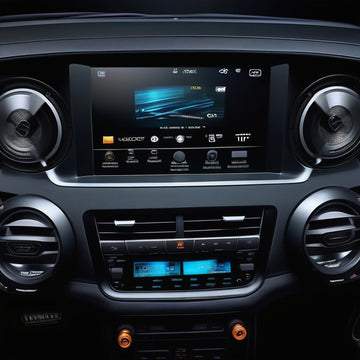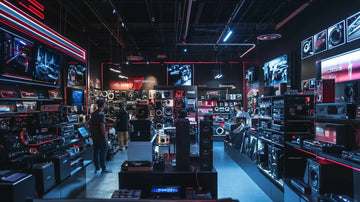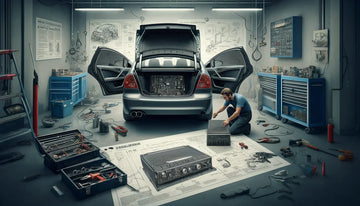Quick Navigation
Complete Guide to Audio System Components
Master Car, Home & Professional Audio Equipment
Car Audio Systems
Mobile sound excellence with road-tested components
Home Audio
Domestic sound perfection in controlled environments
Professional Systems
Studio & live sound for critical applications
Quick Start Guide
Assess Your Needs
Determine your budget, space constraints, and performance goals
Choose Components
Select source, amplification, and speakers that work together
Install & Optimize
Professional installation and tuning for best performance
The Universal Language of Audio
Audio systems have revolutionized how we experience sound, from the first car radio in the 1930s to today's sophisticated multi-room streaming systems and professional studio monitors. Whether you're cruising in your vehicle, relaxing at home, or working in a recording studio, the fundamental principles of audio reproduction remain consistent across all applications.
Understanding audio system components is crucial for anyone looking to enhance their listening experience. This comprehensive guide explores how audio equipment works across different environments - from car audio systems to high-end home theaters to professional recording studios.
Modern audio technology offers unprecedented flexibility with wireless connectivity, digital signal processing, and smart integration. Focus on understanding core components first, then explore advanced features.
Audio Technology Evolution
1930s - First Car Radios
AM radio integration in automobiles
1980s - Digital Audio
CD players and digital processing
2020s - Smart Audio
AI-powered, wireless, voice-controlled systems
Understanding Universal Audio Principles
Audio Signal Flow
Source
Music/Audio Input
Amplification
Power Boost
Transduction
Electrical to Sound
Acoustics
Sound Waves
| System Type | Primary Components | Power Range | Best Application |
|---|---|---|---|
| Car Audio | Head unit, amplifiers, speakers, subwoofer | 50-1000+ watts | Mobile listening, road noise compensation |
| Home Stereo | Receiver, bookshelf/tower speakers | 20-200 watts | Living room music, controlled environment |
| Home Theater | AVR, 5.1+ speakers, subwoofer | 100-500 watts | Movies, immersive surround sound |
| Professional | Interface, monitors, amplifiers | 50-2000+ watts | Recording, mixing, live sound |
Essential Audio System Components
Audio Sources: The Foundation of Every System
Car Audio Sources
The head unit serves as the command center of your car audio system, controlling source selection, volume, and sound processing.
Factory Head Units
Basic functionality with limited customization
Aftermarket Stereos
Enhanced features, better sound processing, custom tuning
Digital Media Receivers
Smartphone-focused units without CD players
Home Audio Sources
Home audio sources have evolved from simple CD players to sophisticated network streamers accessing virtually any audio content worldwide.
Network Streamers
Access Spotify, Tidal, local files, and internet radio
Turntables
Analog vinyl playback with built-in or external phono preamps
Media Servers
Store and serve large digital music libraries
Professional Sources
Professional audio demands the highest fidelity sources with multiple inputs, precise monitoring, and extensive routing capabilities.
Audio Interfaces
Convert analog signals to digital for recording
Mixing Consoles
Multiple input sources with individual processing
Digital Workstations
Computer-based recording and playback systems
Amplification: Powering Your Sound
Amplifier Classes Comparison
Class A/B Amplifiers
- Excellent sound quality
- Linear operation
- Lower efficiency (~65%)
- Best for front speakers
Class D Amplifiers
- High efficiency (~90%)
- Compact size
- Less heat generation
- Ideal for subwoofers
Speakers: Converting Electricity to Sound
| Speaker Type | Configuration | Advantages | Best Application |
|---|---|---|---|
| Coaxial | Tweeter mounted in woofer center | Easy installation, point source | Factory replacements, budget systems |
| Component | Separate woofer, tweeter, crossover | Superior imaging, customizable | High-end car audio, home systems |
| Full-Range | Single driver handles all frequencies | Coherent sound, simple crossover | Vintage systems, specialty applications |
Component Speaker Systems
The gold standard for car audio featuring separate woofers, tweeters, and external crossovers for optimal sound quality and imaging.
- Superior frequency separation
- Customizable tweeter mounting
- Advanced crossover networks
Coaxial Speakers
Full-range speakers with integrated tweeters, offering good performance with easier installation for most applications.
- Direct factory replacement
- Single mounting point
- Cost-effective upgrade
Signal Processing & Connectivity
Digital Signal Processing (DSP)
DSP technology allows precise control over audio signals, correcting acoustic problems and optimizing system performance through digital algorithms.
DSP Functions:
- Time alignment for proper imaging
- Parametric EQ for frequency correction
- Crossover management
- Room/cabin correction
Applications:
- Car audio tuning and optimization
- Home theater calibration
- Professional monitor correction
- Live sound system management
Power Matching Calculator
Calculate the optimal amplifier power for your speakers and determine system requirements.
System Configuration
Recommendations
Enter your speaker specifications to get personalized recommendations
Power Matching Guidelines
- • Amplifier RMS should equal or slightly exceed speaker RMS
- • Higher sensitivity speakers need less power
- • Consider headroom for dynamic peaks
- • Match impedance for optimal performance
System-Specific Applications & Optimization
Car Audio Systems: Mobile Sound Excellence
Installation Process
System Planning
Assess vehicle acoustics and electrical capacity
Head Unit Installation
Replace factory stereo with aftermarket unit
Amplifier Installation
Mount amps with proper ventilation and wiring
Speaker Integration
Install speakers with proper sealing
System Tuning
Configure crossovers and EQ for optimal sound
Unique Challenges
Road Noise
Requires midrange boost and careful component selection for clarity
Temperature Extremes
Components must handle -40°F to 180°F operating range
Electrical Interference
Alternator whine, ignition noise require proper shielding
Component Matching Guidelines
Power Matching
Amplifier RMS should equal or slightly exceed speaker RMS rating
Impedance
Match amplifier output impedance to speaker load (4-ohm typical)
Frequency Response
Ensure speakers can reproduce your preferred music genres effectively
Budget Planning & Performance Tiers
| Budget Level | Car Audio | Home Stereo | Performance Expectations |
|---|---|---|---|
| Entry Level | $500-1,500 | $300-1,000 | Significant improvement over factory systems |
| Mid-Range | $1,500-5,000 | $1,000-3,000 | Excellent sound quality, advanced features |
| High-End | $5,000-15,000+ | $3,000-10,000+ | Reference-quality performance, custom features |
System Optimization & Troubleshooting
Common Symptoms:
- • Engine whine that varies with RPM
- • Alternator noise or electrical interference
- • Ground loop hum or buzzing
- • Radio frequency interference
- • Turn signal or ignition noise
Solutions:
- • Install noise filters on power and signal lines
- • Improve grounding with dedicated ground points
- • Use shielded cables for signal connections
- • Separate power and signal cable routing
- • Install capacitors to filter power supply noise
Diagnostic Steps:
- • Check all connections with multimeter
- • Verify proper wire gauge for amperage
- • Test continuity of all cables
- • Inspect for physical damage or wear
Intermittent operation usually indicates loose connections, corroded terminals, or inadequate wire gauge. Use proper testing equipment to identify the root cause.
Distortion Problems
- • Check gain settings on amplifiers
- • Verify input signal quality
- • Ensure adequate power supply
Poor Imaging
- • Adjust speaker positioning
- • Configure time alignment
- • Check phase relationships
Frequency Issues
- • Use RTA to identify problems
- • Adjust parametric EQ settings
- • Consider acoustic treatments
Frequently Asked Questions
Every audio system requires four fundamental components: an audio source (head unit, receiver, or streaming device), amplification (built-in or separate amplifiers), speakers (transducers that create sound waves), and connectivity (cables and signal processing). These components work together to convert stored or streamed audio into audible sound waves.
Car audio systems face unique challenges including road noise, electrical interference, temperature extremes, and irregular cabin acoustics. They require more efficient amplifiers, speakers designed for automotive mounting, and DSP processing to compensate for acoustic limitations. Home systems benefit from stable power, controlled environments, and flexible component placement, allowing focus on ultimate sound quality rather than efficiency and durability constraints.
Amplifier power should match or slightly exceed speaker RMS ratings for optimal performance. Consider speaker efficiency (sensitivity) when calculating power needs - efficient speakers (90dB+) need less power than inefficient designs (85dB or below).
Typical Power Requirements:
- • Car speakers: 25-100 watts RMS per channel
- • Home systems: 20-200 watts depending on room size
- • Professional monitors: 50-500+ watts per driver
Yes, you can mix different brands as long as components are electrically compatible (proper impedance matching, power handling, and input/output levels). However, staying within one manufacturer's ecosystem often provides better integration, consistent sound character, and simplified system configuration. Focus on electrical specifications rather than brand matching for optimal results.
Ready to Build Your Perfect Audio System?
Explore our complete selection of premium audio components
Conclusion: Building Your Perfect Audio System
Understanding audio system components empowers you to make informed decisions whether you're upgrading your car's factory stereo, building a high-end home theater, or setting up a professional recording studio. The fundamental principles remain consistent across all applications: quality source material, appropriate amplification, well-designed speakers, and proper system integration.
Success in audio system design comes from balancing performance requirements with practical constraints like budget, space, and installation complexity. Start with a clear understanding of your goals, research components thoroughly, and don't hesitate to seek professional guidance for complex installations or optimization.
Whether you're passionate about car audio, home stereo systems, or professional sound reinforcement, the principles outlined in this guide provide the foundation for achieving exceptional audio experiences. Remember that great sound is ultimately about the music, not just the equipment - choose components that serve your musical enjoyment above all else.




